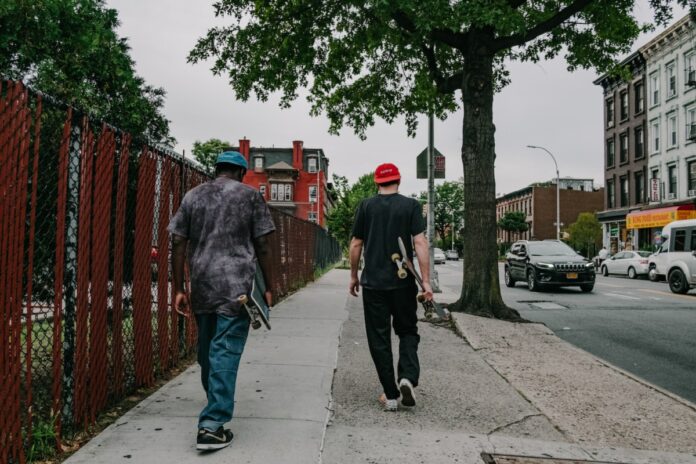If you live in the big apple, or if you’re a diehard fan of the sitcom Everybody Hates Chris, then you’ve heard of Bedford-Stuyvesant: the diverse Brooklyn neighborhood with some of the best comfort food in the city. But did you know that Bed-Stuy is made up of four smaller neighborhoods? Much like Captain Planet, the powers of Ocean Hill, Weeksville, Bedford, and Stuyvesant Heights combine to form the mighty neighborhood that was once home to the likes of Jay-Z and Jackie Robinson.
Where Does The Name Stuyvesant Heights Come From?
As you might have guessed, the name comes from the “Bedford” and “Stuyvesant Heights” portion of the neighborhood, proving that New Yorkers have always liked to come up with cute little combo nicknames for neighborhoods such as SoHo or Tribeca. However, unlike Stuyswick, a combination of Stuyvesant and Bushwick that roughly translates to “I live on the border of these clearly separate neighborhoods and want to sound cool,” Bed-Stuy has fully incorporated its four founding area codes into a singular identity. Nowadays, it’s very rare to hear someone refer to Bedford or Stuyvesant Heights as their own neighborhood. But how did we get here?
Stuyvesant Heights was founded in 1640 by Dutch colonialist Peter Stuyvesant. If the name “Stuyvesant” seems familiar to you, it’s because too many things in New York are named after this man. He was the last governor of New Netherlands, overseeing the overturning of the colony to the British in 1664. For most of its early life, Stuyvesant Heights was not a neighborhood, but farmland that was incorporated into the town of Breuckelen. If the name “Breuckelen” seems familiar, that’s because it’s just “Brooklyn” spelled funny. Names would be one of the only influences the Dutch had on the neighborhood, as they weren’t around to see the transformation from farmland to residential area.
By 1668, the land was going by the name “Bedford Corners” and was home to a flourishing Inn and market center. The land was incorporated into the Town of Brooklyn in 1800 as part of Kings County. As the population of the city expanded, rural areas, like Stuyvesant Heights, were being transformed into residential areas. Some larger homes already existed in the district, such as the Akwaaba Mansion, built in 1860. However, seeking to urbanize, the first row of masonry houses was built in 1872. By 1890, the name Stuyvesant Heights finally made its appearance to distinguish the area from the rest of Brooklyn and attract new homeowners.
Between the 1870’s and the 1930’s, Stuyvesant Heights was home to mostly rich/middle-class white families. Some working-class folk lived in the area, but the rows of Brownstones and leftover mansions made the area expensive. When the Great Depression hit, many of these homes were lost or abandoned, lowering prices, and opening the door for newly arrived immigrants and southern black families. By the 1960’s, black families made up about 85% of Stuyvesant Heights population.
Due to redlining, brutal over policing, and a lack of federal aid, Stuyvesant Heights, and the rest of Bed-Stuy, was essentially forced into poverty. This led to tensions between the neighborhood and the city leadership. In 1965, a civil suit was filed against said racist gerrymandering (the neighborhood was split into five districts, each with a white representative) and resulted in the creation of New York’s 12th congressional district, redrawing nearly all of Brooklyn’s district lines. This paved the way for the first black congresswomen, Shirley Chisholm. Stuyvesant Heights part in particular, has been an epicenter of black art and culture for decades. The neighborhood boasts a roster of industry leaders from comedian Chris Rock to singer Lena Horne. In fact, many musicians have lived in the area. Biggie Smalls, Eubie Blake, and Max Roach all called the neighborhood “home” at one point.
Gentrification of Stuyvesant Heights
Today, the Stuyvesant Heights historic district is one of the most coveted neighborhoods to live in. Recent gentrification has driven prices up, but the effort to preserve the historic and black roots of the neighborhood keeps the area humble and grounded. The protected brownstones lining the streets of Stuyvesant Heights keep the area a “low rise” neighborhood, vastly different from the newer homes and high rises that are beginning to pepper the rest of Bed-Stuy.
A neighborhood is defined by its homes and landmarks, which makes the historic Stuyvesant Heights truly unique. Each street is protected in some way and history’s mysteries can be found anywhere you look. A great way to find these hidden gems is through the eyes of the Brownstoners of Bedford-Stuyvesant, a group of black homeowners dedicated to showcasing the beauty and culture of the neighborhood. They give an annual tour of the neighborhood homes, even doing virtual ones during the pandemic.
If you’re a fan of old sitcoms, it might interest you to know that The Honeymooners references Stuyvesant Heights. The show itself takes place in Bensonhurst, but it’s largely based on Jackie Gleason’s life in Bed-Stuy. His address in the show is 328 Chauncey, which is the same address Gleason grew up in. The address even gets fan mail to this day.
Crime in Stuyvesant Heights
There’s a piece of true crime history for those of you who are into strangers committing murder. Martha Place, the first woman to be executed by the electric chair in 1899, lived on Hancock Street. She was sentenced to death after she was accused of murdering her stepdaughter and attacking her husband with an axe. Though to be honest, the whole situation seems fishy to me. The key witness was her husband, who was the only other person in the house and the one who got the police. Martha was found in critical condition when the police arrived, and her stepdaughter was found with photographer’s acid (which was often used by the husband) in her eyes. But I digress.
Is Stuyvesant Heights Safe?
True crime stories aside, per the Furman Center, the serious crime rate in 2023 for that area was on par with the crime rate for the whole city and, per Weichert, only slightly above the national average.
Why Is Stuyvesant Heights So Special?
Stuyvesant Heights is a unique area of New York City that went from Dutch Colonial farmland to socialite paradise to a black culture center over the course of its diverse history. It’s seen battles for both revolution and equality, as well as artistic movements that are still influential to this day. The evolution of this place is complex, not just because of its history, but because of how it fused with other neighborhoods yet was able to remain completely unique. Visiting this historic district is worth the trip, whether you live in the city or you’re in New York for a vacation. So head on over to Stuyvesant Heights for the sights and sounds of this neighborhood within a neighborhood.
Russell is a writer and comic based in New York City. His plays have been featured at Penn State’s Cultural Conversation’s Festival, The NYC Thespis Festival, and Imaginarium’s Inaugural Theater Festival. Follow him on TikTok and Instagram @pooleparty528



